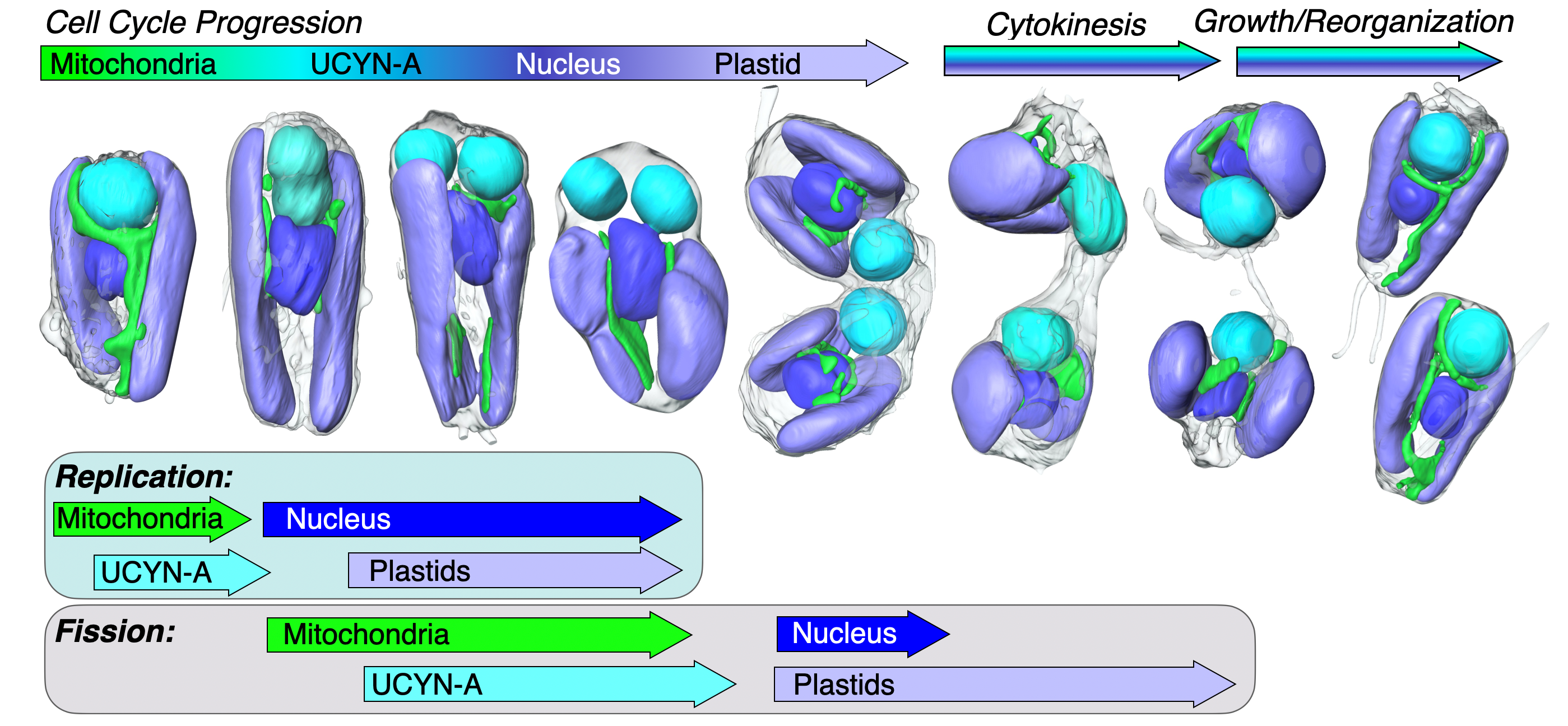Nitroplast: Symbiont-Turned-Organelle Fixes Nitrogen for Alga
04/12/2024

Nitroplast Replication Fully Integrated with Algal Cellular Machinery. Three-dimensional soft X-ray tomography renderings of the marine alga Braarudosphaera bigelowii depict the replication and fission of nitroplast (UCYN-A) and B. bigelowiiorganelles.
[From Coale, T. H., et al. 2024. “Nitrogen-Fixing Organelle in a Marine Alga,” Science 384(6692), 217-22. Reprinted with permission from AAAS.]
The Science
Eukaryotic cells differ notably from prokaryotes in that they contain membrane-bound organelles with specific functions. A few of these organelles, such as mitochondria and chloroplasts, started out as endosymbiotic bacteria but evolved to become fully integrated into the host cell.
An international team of scientists from the University of California at Santa Cruz, Lawrence Berkeley National Laboratory, and other institutions now report close integration of the nitrogen-fixing cyanobacterial endosymbiont Candidatus Atelocyanobacterium thalassa into the architecture and function of its unicellular marine algae host Braarudosphaera bigelowii. Proteomic and X-ray tomographic evidence reveal that this close integration is more characteristic of an organelle than an endosymbiont.
The findings suggest that Candidatus A. thalassa evolved from a symbiont to a eukaryotic organelle for nitrogen fixation—named the nitroplast—thereby expanding to eukaryotes a function that was thought to be exclusively carried out by prokaryotic cells.
The Impact
The marine alga B. bigelowii is the first known eukaryote to pull nitrogen from the air. As reported in a Science perspective article, the “new data support the claim that nitrogen fixation is no longer an exclusive prokaryotic function and that eukaryotes can fix molecular nitrogen through the nitroplast. The nitroplast represents a textbook case of a eukaryotic organelle that complements the energy, carbon, and nitrogen needs of the algal host and is another example of how ecology is the theater where evolution takes place.”
The discovery is of great interest for understanding organelle genesis and for efforts to engineer agricultural plants with built-in nitrogen-fixing capabilities.
The Summary
Evidence distinguishing the nitroplast nitrogen-fixing organelle from an endosymbiont comes from proteomics and soft x-ray tomography (SXT) conducted at the National Center for X-ray Tomography at the Advanced Light Source. SXT shows that division of the nitroplast organelle is coordinated with that of the other organelles and omics studies indicate that half of the nitroplast proteins were imported from the B. bigelowii host genome nucleus to fill in gaps in its metabolic pathways.
Rather than symbiont genomes migrating into the host’s nuclear genome, the host genome appears to support the symbiont. This suggests that the nitroplasts result from primary endosymbiosis—the process by which a symbiont is engulfed by a host organism and evolves beyond symbiosis to become part of the host cells. This evolutionary process is analogous to what occurred with mitochondria and chloroplasts.
The discovery raises the prospect of engineering plants that can fix nitrogen directly from the air, reducing the need for synthetic nitrogen fertilizers, the production of which generates enormous amounts of carbon dioxide.
Funding
This work was supported by: Simons Foundation grants 724220 and 824082; National Institute of General Medical Sciences P30GM138441 (National Center for X-ray Tomography); DOE’s Biological and Environmental Research program DE-AC02-05CH11231 (National Center for X-ray Tomography); and the Japan Society for the Promotion of Science KAKENHI grants 17K05694 and 20H04325. Operation of the ALS is supported by DOE Office of Science, Basic Energy Sciences program.
Related Links
- BER Resource: National Center for X-Ray Tomography
- Science News Article: “This Marine Alga is the First Known Eukaryote to Pull Nitrogen from Air”
- Science Perspective: “The Nitroplast: A Nitrogen-Fixing Organelle”
- ALS News: "Symbiotic Nitrogen-Fixing Microbe Evolves into Organelle"
References
Coale, T. H., et al. 2024. “Nitrogen-Fixing Organelle in a Marine Alga,” Science 384(6692), 217-22. DOI:10.1126/science.adk1075.
